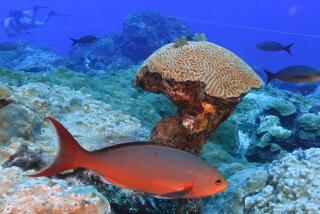Racing the oil sheen, biologists take a bird census
Reporting from Theriot, La. — The dozen biologists on Point Au Fer Island were on an 11th-hour mission to count what was there before it was gone.
Nearly two months into the Deepwater Horizon oil disaster, which has dumped millions of barrels of oil into the Gulf of Mexico, they were counting birds guarding chicks and eggs. Trying to ignore the sweltering heat and stinging deer flies, the biologists strode across the island’s remote beaches and sandbars for two days last week to take stock of avian life before oil comes ashore.
Essentially, they wanted to estimate the populations of American oystercatchers, common nighthawks, least terns, Wilson’s plovers and other species for use in charting what they fear could be a drastically downward trend over the next several decades.
Environmentalists are wary that a shift in weather and ocean currents will bring oil and toxic chemicals from the breakdown of petroleum into Atchafalaya Bay, about 75 miles southwest of New Orleans.
The data collected during the two-day survey may help answer crucial questions at the heart of the disaster: What effect will oil and dispersants have on one of the nation’s biggest breeding grounds for birds, and how long will it take to recover? Or will it?
“There is a sense of urgency to get remote places like this thoroughly surveyed before the oil hits,” said Steven Cardiff, collections manager of birds and mammals at Louisiana State University’s Museum of Natural Sciences. “A high tide with oil and a strong wind, and it’s all gone.”
The oil slick has already despoiled coastal estuaries a few miles east of this 20-mile-long island, killing untold numbers of birds, fish, turtles and mammals, and ruining their delicate bayou habitat, perhaps for years to come. Compounding problems, cleanup crews using booms, earth movers and shovels have inadvertently crushed nests, eggs and newly hatched chicks.
Against a backdrop of oil rigs rearing skyward, the island’s windswept shores were strewn with clutches of speckled gray eggs resting in slight depressions in the sand amid broken oyster shells.
Scads of fiddler crabs — a favorite food of Wilson’s plovers — scuttled across mud flats pocked with tracks of coyotes and raccoons. Butterflies flitted over knee-high grass. Male nighthawks swooped under roiling thunderheads. On all sides, the air was filled with bird calls: the throaty trills of orchard orioles, the raspy calls of terns bringing fish to their demanding young.
The team scanned the sun-baked ground to avoid crushing eggs or chicks under their boots. Adult birds tried to lure the human intruders away from their nests by pretending to have broken wings, or diving low over their heads.
Team member Steve Liptay, assistant director of Coastal Bird Conservation, a nonprofit organization dedicated to research and survey work, jotted down every sighting — species, location, date, time — on a clipboard.
“Some people are proposing that surveys like this one be conducted every 10 days in order to track the impacts as closely as possible,” Liptay said. “At the very least, I hope we can return soon with signs to warn people away from known nesting sites.”
A few yards away, as Cardiff made his way along the shoreline, he spied a dark glob just a few inches away from a least tern nest harboring a single egg.
His face fell. “It’s a tar ball,” he said, shaking his head.
By the survey’s end Wednesday, team members had trudged across 30 miles of beaches and counted roughly 120 pairs of Wilson’s plovers, 500 pairs of least terns, 750 individual nighthawks and six pairs of American oystercatchers.
Habitat for these and many other migratory birds was already in distress long before crude oil began bursting from BP’s blown-out well on April 20. Louisiana loses about 25 square miles of coastal marshlands each year because of development, petroleum exploration and altered flows of Mississippi River sediment.
The survey was only one of many studies started in recent weeks by environmental organizations, Louisiana State University and state and federal agencies to track the oil’s destructive force.
“The whole ecological system is falling apart,” said Richard DeMay, senior scientist with the Barataria Terrebonne National Estuary Program, and captain of one of two vessels used to ferry biologists to the shores of Point Au Fer Island.
“This survey and others will help us get a handle on what we have out there now, and what we may lose over time,” he said. “Scientists will be studying the results for years to come.”
More to Read
Sign up for Essential California
The most important California stories and recommendations in your inbox every morning.
You may occasionally receive promotional content from the Los Angeles Times.











